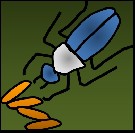Pesticides and natural enemies
What is a pesticide?
In most local languages, the word used for ‘cure’ or ‘medicine’ is also often used for pesticides. However, pesticides are neither cures nor medicines, but rather poisons that kill. This becomes clearer when one studies their names and meanings:
· Insecticide = kills insects
· Raticide = kills rats
· Fungicide = kills fungi
· Bactericide = kills bacteria
· Herbicide = kills weeds
· Nematicide = kills nematodes (nematodes are microscopic worms).
Some pesticides have an effect on respiration or on digestion. Others kill indirectly by their effects on development or reproduction. Whatever the mechanism of action, the result is identical: the harmful insect is killed. However, it is not only the harmful insect that is affected! Other insects, including natural enemies, and even animals or humans may fall ill or die because they came into contact with pesticides.
We should avoid calling pesticides ‘cures’ or ‘medicine’ and call them what they are: poisons. By doing so, we remind ourselves and others that pesticides are dangerous and that their use ought to be as limited as possible. If it becomes absolutely necessary to use them, they must be used with great care, as they are dangerous for human health and for the environment.
Insecticides can be divided into two groups according to the way they work. Some are immediately absorbed by the insects when they come into contact with the insecticide: these are contact insecticides. These insecticides are sprayed over plants and the insects come into contact while moving over the plant. The other insecticides are systemic, as they enter the insect body through their food, and the insecticide will kill the insect when it goes through its intestines. Systemic insecticides are applied as granules sprinkled on the ground, which are absorbed by the plants. When the insects eat the plants, they also swallow the pesticide. Both insecticides are toxic to natural enemies.
Pesticides, natural enemies and harmful insects
Most farmers have noticed that the problems with insect pests like aphids and other small size insects appeared after they began using insecticides. Two reasons can explain this phenomenon:
-
Insecticides never kill all the insect pests in a field. The insects that survive are more resistant to the pesticide than those that died. The surviving insects are those which will reproduce and transmit their resistance characteristics to the next generation. If the insecticide is applied often and at high doses, the selection for resistant insects occurs very quickly. Insects with a short life cycle like aphids can rapidly develop resistance to insecticides.
-
Pesticides kill natural enemies, which are more susceptible to pesticides than the insect pests are. Furthermore, the life-cycle of natural enemies is generally longer than that of harmful insects, which means that natural enemies need a longer period to recover and thus for their population to reach its previous size. Without their natural enemies to limit their number, the harmful insects can multiply very rapidly.
Pesticides and human health
Pesticides can have acute or chronic effects on human health. The acute symptoms of poisoning are nausea, vomiting, disturbed vision and trembling. When pesticides are frequently used over a long time, the effects can become chronic and the symptoms may be blood pressure changes, heart problems, skin (dermatological) problems, neurological problems and cancers. Pesticides can kill human beings. The United Nations World Health Organization (WHO) has published that, each year, about 1 million people are poisoned by pesticides, and that 20,000 die from their effects.
Some safety rules
To prevent dangers linked to pesticide use, it is important to follow some basic safety rules:
-
Always wear protection equipment (mask, glasses, gloves and boots) while treating.
-
Respect recommendations about doses and associations with other products.
-
Avoid, as much as possible, applying products when it is very hot or very sunny (between 11:00 and 16:00), and walking into the wind.
-
Never smoke while treating, nor before washing thoroughly.
-
Ask people standing close, especially those placed down-wind, to move away while treating.
-
Thoroughly clean treatment and protection equipment after use and store far from food and out of reach of children.
-
Take care not to clean the equipment or to throw away any solution remaining in an area close to a source of water used for home or cooking purposes.
-
If, by accident, the product comes into contact with the eyes, nose or mouth, rinse with abundant water and go to the closest health center, if possible, with the references of the product (packaging or label).













